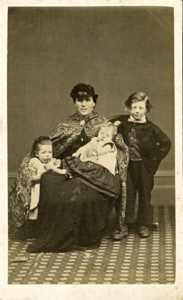Although there were diverse relationships on the goldfields the most prevalent and most stable was the monogamous marriage. In Ballarat in the early 1850s there was an abundance of men who outnumbered women 4 to 1, so that most women between 20 and 40 years of age were in a marital situation.
This meant that most women were experiencing childbirth and motherhood. Holloway’s and Dr L L Smith’s Vegetable Pills, which claimed ‘As a Female Pill they stand unrivalled’, were advertised as cures for all ‘disorders’ for women and were possibly used as a preventative measure. Basically they acted as purgatives or emetics, and were essentially ineffective as pills for birth control, as larger families on the goldfields testify. A random sample of families shows that Harriet South produced 13 children in 21 years, Margaret Toohey produced 7 children in 11 years, and Eliza McQuade produced 11 children in 25 years.
Mothers on the goldfields tried to create a pleasant environment for their husbands and families. Martha Clendinning, when she set up her diggings store added little touches, such as her canary which she always hung in its cage outside her tent. Ellen Clacy in her writings noted too that ‘a pet cockatoo, chained to a perch, makes noise enough to keep the “missus” from feeling lonely when the good man is at work’.
Mothers on the goldfields had their work cut out in trying to make their homes safe and healthy. Women regularly took care of children and the household which included cooking, cleaning, and gardening. Times could be hard and emotionally difficult. Bridget Ruane for example mothered her child to the best of her ability. The 12 day old premature baby ‘was always screaming and heaving up everything from her stomach’. On the morning of November 13, 1863 Bridget ‘brought her to Ballarat to get her christened’. Because of medical circumstances beyond Bridget’s control, the baby did not survive.
Women with children often looked after other children as well as their own. Anne Healey was ‘in Mrs Cody’s house about six o’clock’ when Cody ‘went out on some business to the butcher’s on Redan Lead’. Healey was then looking after ‘seven or eight children’ who were in the house at the time, as well as a baby around 16 months old, active enough to climb out of its cradle.
The trials of cooking in the open were demanding for mothers. There are reports of curry and rice, spices, sultanas with treacle, and other delicacies being consumed. The heat and flies were unbearable in summer and the winters were cold and icy which made cooking difficult. Martha Clendinning wrote of her intent to keep her tent ‘bright and cheerful’. Other women related how they kept the house clean and tidy, or how they tended a cottage garden in order to have fresh vegetables for cooking. Boots were put on window sills to dry, water was always boiling on an open fire to make a cup of tea or coffee, partitions were made with cloth so that bedrooms were separate to the living quarters. Mothers on the goldfields through such practical measures were active in domesticating the living space for themselves and their families and making life on the goldfields more pleasant.
